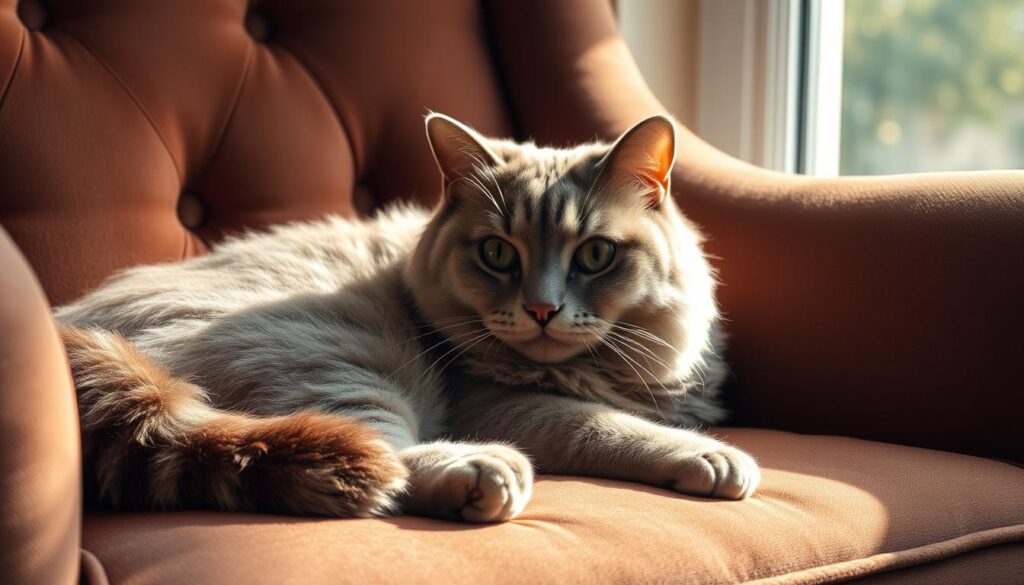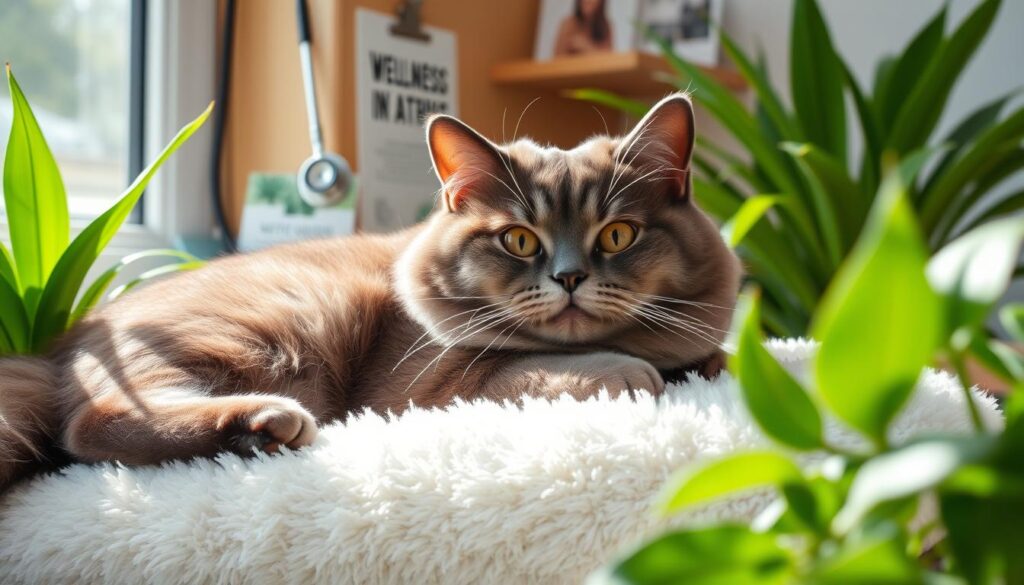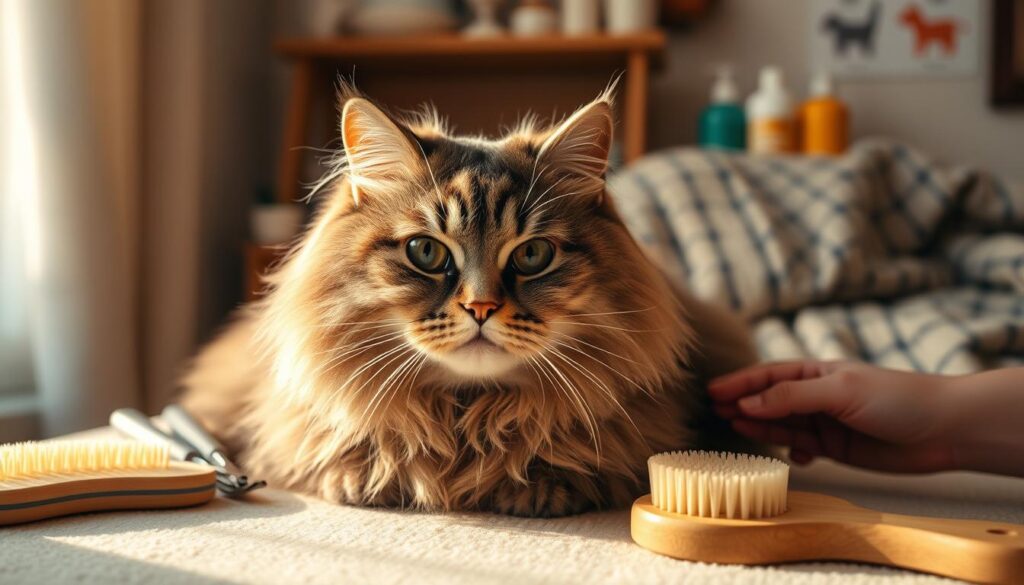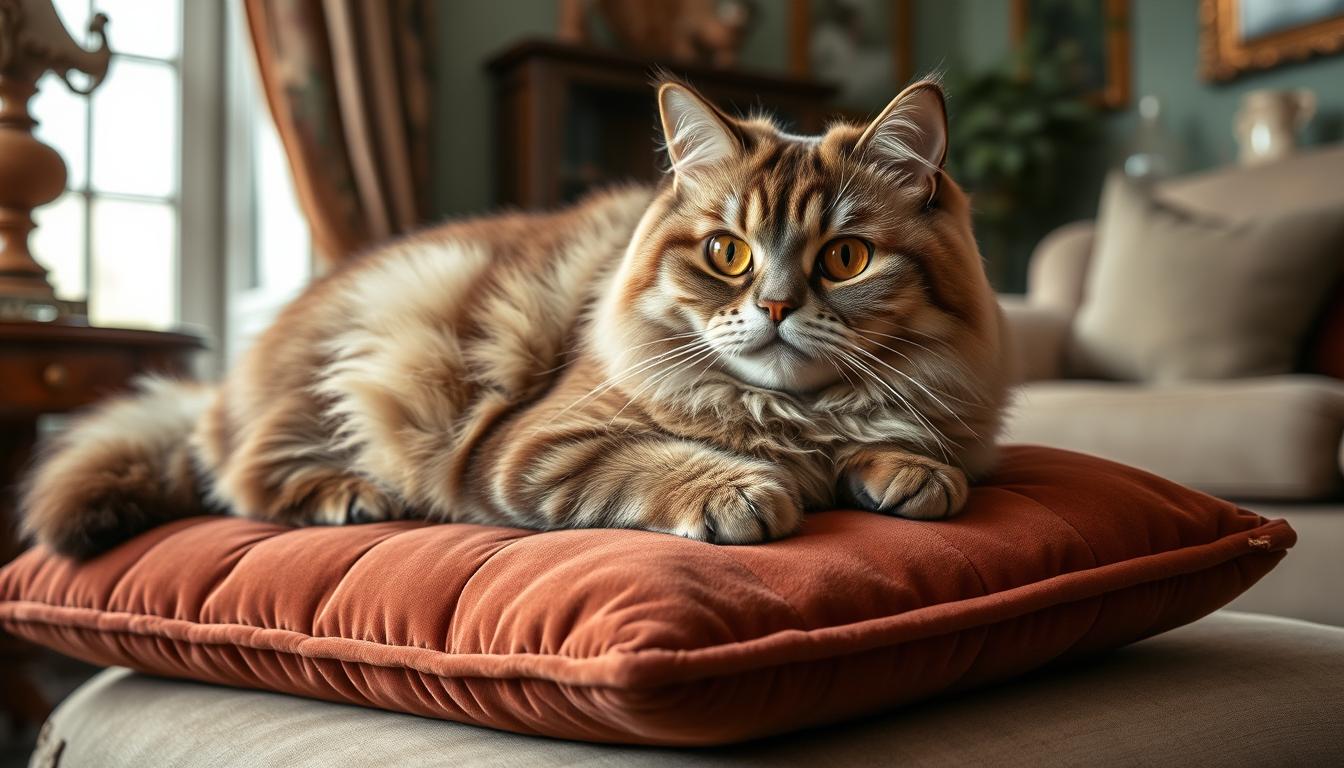The British Shorthair is a favorite cat breed known for its sturdy build and short coat. It has a long history, dating back to ancient Rome. For centuries, it has been a popular pet in the United Kingdom. This breed is unique and has gained fans all over the world.
The British Shorthair stands out with its broad face and distinctive look. Its rich history and charming personality make it a favorite among cat lovers. Whether you’re new to cats or have had them before, the British Shorthair is worth considering.
In this article, we’ll explore the British Shorthair’s characteristics, temperament, and care needs. We’ll look at its origins and why it’s so popular today. You’ll learn everything you need to know about this captivating feline breed.
Key Takeaways
- The British Shorthair is a beloved feline breed with a long history.
- This breed is known for its sturdy build and short coat.
- The British Shorthair has a broad face and a distinctive appearance.
- The breed has a rich history, dating back to ancient Rome.
- The British Shorthair is a popular companion animal in the United Kingdom and worldwide.
- This breed is suitable for seasoned cat owners and newcomers alike.
The Rich Heritage of British Shorthairs
The British Shorthair is a popular cat breed with a long history. It goes back over 2,000 years. This cat breed started in ancient Rome. It was prized for its hunting and companionship.
Over time, the breed changed. It became the sturdy and loving cat we see today.
Some key events in the history of British Shorthairs include:
- Ancient Roman origins, where they were bred for their strength and agility
- Evolution through British history, where they were highly valued as working cats
- Modern breed development, where they were recognized as a distinct breed
Today, British Shorthairs are among the most popular cats globally. They are known for their easy-going and affectionate nature. They make great companions for many families.
If you’re a cat lover or just curious, the British Shorthair is worth exploring. With their rich history, unique looks, and loving nature, it’s easy to see why they’re so beloved.
Distinctive Physical Features of the British Shorthair
The British Shorthair is a medium-sized cat with a sturdy build and broad face. It has a short, dense coat in many colors and patterns. This makes each British Shorthair unique.
This breed is known for being easy-going and affectionate. They are great as family pets because of their calm nature. They get along well with children and other pets.
Some key physical features of the British Shorthair include:
- A short, easy-to-maintain coat
- A broad, rounded face with a short nose
- Wide-set ears and large, round eyes
- A sturdy, muscular build
The British Shorthair’s physical features and loving temperament make it a favorite among cat owners. They need regular grooming and exercise to stay healthy.
Understanding the British Shorthair’s Unique Coat
The British Shorthair’s coat is a standout feature of the breed. It’s short, dense, and crisp. Taking good care of it is key to keeping it healthy and looking great.
Some key aspects of the British Shorthair’s coat include:
- Coat colors and patterns: The British Shorthair comes in a wide range of colors and patterns, including solid, bi-color, and tabby.
- Texture and density: The coat is short and dense, with a crisp texture that requires regular grooming to prevent matting.
- Seasonal changes: The British Shorthair’s coat may change with the seasons, with a thicker coat in the winter and a lighter coat in the summer.
Knowing the unique traits of the British Shorthair’s coat helps owners give the best cat care and grooming. This keeps their pet happy and healthy.
The Gentle Giant Personality
The British Shorthair is known for being gentle and loving. It’s called a “gentle giant” because of its strong build and calm nature. When looking into breed information, it’s key to understand their personality and needs.
This breed is laid-back and calm. They are great for families with kids or anyone who wants a peaceful pet.
Some key traits of the British Shorthair’s personality include:
- Playful, but not overly demanding
- Affectionate, but not clingy
- Intelligent, but not prone to destructive behavior
These qualities make them perfect companions for many homes. As you learn more about the British Shorthair, you’ll see why they’re so loved.

Knowing the British Shorthair’s personality is important for their care. By understanding their unique traits, you can make a happy home for them. Whether you’re new to cats or not, their charming nature will capture your heart.
Essential Care Requirements for Your British Shorthair
The British Shorthair is a beloved cat breed. They need regular care to stay happy and healthy. Knowing what care they need is key for any cat owner.
Creating a good environment is crucial. This means a daily routine, exercise, and mental games. A well-cared-for British Shorthair will be a loving friend.
Daily Care Routine
Here’s what your daily routine should include:
- Feeding a balanced diet
- Providing fresh water
- Cleaning the litter box
- Spending quality time with your cat
Exercise Needs
British Shorthairs don’t need a lot of exercise. But, they do need some physical activity. Play with them using a ball or toy.
Mental Stimulation
Mental games are important for your cat’s happiness. Use puzzle toys or interactive games to keep them engaged.
By following these care tips, your British Shorthair will be happy and healthy. They’ll make a great pet as a feline or cat breed.
Nutrition and Feeding Guidelines
The British Shorthair is a favorite cat breed. They need a balanced diet to stay healthy. A well-fed British Shorthair will have a shiny coat, bright eyes, and a strong build.
To keep your cat healthy, it’s important to know what they need to eat.
Dietary Requirements
A British Shorthair’s diet should include high-quality protein like chicken or fish. They also need complex carbs, such as brown rice or oats. Learning about common health problems in cats helps you choose the right food. Make sure your cat always has fresh water.
Meal Planning
Planning meals for your British Shorthair is easy. You can choose between dry food or wet food, or a mix of both. Some cats, like the British Shorthair, may need a special meal plan. They might need smaller, more frequent meals to avoid getting too fat.
Weight Management
Keeping your British Shorthair at a healthy weight is key. They can easily get overweight. To avoid this, you can:
- Watch how much they eat
- Make sure they get enough exercise
- Feed them a balanced diet
By following these tips, your British Shorthair can stay healthy and live a long, happy life.
Grooming Your British Shorthair
British Shorthairs have short, dense coats that need regular grooming. Owners should brush their cat’s coat weekly. This removes loose hair and spreads skin oils, keeping the coat shiny and preventing mats.
Nail care is also key for grooming. Trimming nails every few weeks stops them from growing too long. This can cause pain and health issues. Cleaning their ears is also important to avoid infections. Use a cotton ball and mild solution for this.
Remember, grooming suits a British Shorthair’s calm nature. But, some may be more sensitive. So, groom them patiently and carefully. A regular grooming routine keeps your British Shorthair happy and healthy.
Here are some tips for grooming your British Shorthair:
- Brush their coat at least once a week
- Trim their nails every few weeks
- Clean their ears regularly
- Be patient and gentle when grooming
Health Considerations and Common Issues
The British Shorthair is generally a healthy breed. However, it can face some health issues. Regular grooming and vet visits can spot problems early. Knowing about the breed’s health concerns and taking steps to prevent them is key to a long, healthy life for your British Shorthair.
Genetic Health Concerns
British Shorthairs might get hypertrophic cardiomyopathy and hip dysplasia. Good breeding practices and genetic tests can lower these risks. When looking for a breed information, choose reputable breeders who focus on health and honesty.
Preventive Care
Preventive care is vital for your British Shorthair’s health. This includes vaccinations, parasite control, and dental care. A good diet and exercise are also important. Keeping up with grooming and health checks can prevent many issues and keep your British Shorthair healthy and happy.

Regular Health Checks
Regular vet visits are crucial for your British Shorthair’s health. These visits should include a physical exam, blood tests, and other needed tests. By focusing on your British Shorthair’s health and staying informed about breed information, you can ensure a long, joyful life for your pet.
Creating the Perfect Living Environment
As a British Shorthair owner, it’s key to give your cat a comfy and safe home. This medium-sized cat needs a space where it can move freely and relax. Think about your cat’s natural instincts and needs when setting up the perfect living area.
A good living space should have essential equipment like scratching posts, litter boxes, and feeding stations. It should also have safety features like secure windows and doors to stop escape or injury. Plus, remember your British Shorthair loves vertical space. So, add cat shelves or climbing structures to keep them active and fun.
Space Requirements
The British Shorthair needs a moderate amount of space to move around easily. Aim for at least 100 square feet of living space. This should include a dedicated cat room or a big area of your home for your feline friend.
Essential Equipment
Some must-have items for your British Shorthair include:
- Scratching posts to keep nails healthy and provide exercise
- Litter boxes with low sides for easy access
- Feeding stations with separate areas for food and water
- Cat beds or mattresses for cozy rest
Safety Considerations
When setting up your British Shorthair’s home, safety is crucial. Make sure all windows and doors are secure. You might want to install window guards or screens to stop escape. Also, keep toxic substances and electrical cords away to avoid injury or accidents.
Social Behavior and Family Integration
The British Shorthair is a very social cat breed that loves being around people. They are great with families, making them a popular choice. Family dynamics are key to their socialization, and they bond strongly with their owners.
British Shorthairs are easy-going and get along well with other pets. If you socialize them early, they’ll be fine with others. Here are some tips for socializing your British Shorthair:
- Introduce them to new people and pets gradually
- Provide a safe and comfortable environment for socialization
- Encourage positive interactions with rewards and praise
British Shorthairs are perfect for families with kids. They’re patient, gentle, and loving. With the right care and socialization, they’ll become a cherished family member.
Training Your British Shorthair
British Shorthairs are smart and can learn with patience and consistency. Knowing your cat’s personality is key to a good training plan. They are calm and eager to please, making them easy to train.
Positive reinforcement is the best way to train your British Shorthair. This method strengthens your bond and encourages good behavior. Focus on:
- Basic commands, such as “sit” and “stay”
- Litter box training, to ensure your cat uses the litter box consistently
- Behavioral management, to address any unwanted behaviors, such as scratching furniture
Understanding your British Shorthair’s unique traits helps tailor your training. With patience and positive reinforcement, they’ll become a loving and well-behaved pet.
Every cat is unique, and what works for one might not work for another. By getting to know your cat’s personality, you can create a training plan that fits their needs.
Breeding Considerations
When breeding British Shorthairs, cat care and grooming are key. It’s important to pick breeding cats with good traits like a strong build and a short, simple coat. Breeders also need to think about the genetic diversity to avoid health issues.
Genetic testing is a big part of breeding British Shorthairs. It helps find genetic disorders like hypertrophic cardiomyopathy. This way, breeders can choose the right cats to breed, ensuring their kittens are healthy.
Important things to think about when breeding British Shorthairs include:
- Choosing breeding cats with good traits
- Genetic testing for health problems
- Good cat care and grooming for health and happiness
By focusing on these, breeders can raise healthy, friendly British Shorthair kittens. 
Cost of British Shorthair Ownership
Thinking about getting a British Shorthair? It’s key to know the costs. These cats need time, money, and care. You’ll spend on initial costs and ongoing expenses, including insurance.
The first cost for a British Shorthair is $600 to $1,200. This includes the kitten’s price, vaccinations, and spaying or neutering. Breed information helps choose a good breeder and understand costs.
Initial Investment
- Purchase price of the kitten: $600 to $1,200
- Initial vaccinations: $50 to $100
- Spaying or neutering: $50 to $200
After buying your cat, you’ll spend on food, litter, and vet visits. Food and litter cost about $50 to $75 monthly. Vet care can be $500 to $1,000 yearly, based on your cat’s health and age.
Ongoing Expenses
- Food and litter: $50 to $75 per month
- Veterinary care: $500 to $1,000 per year
Insurance is also important for British Shorthairs. It covers vet bills, giving you peace of mind. Knowing the costs helps you give your cat a great life and enjoy the breed’s benefits.
Common Misconceptions About British Shorthairs
The British Shorthair is a well-known feline breed but often misunderstood. People think they are lazy, but they are actually laid-back and easy-going. They are very affectionate and playful, making them great for families and individuals.
Many believe British Shorthairs need a lot of grooming. But, their short coats are easy to care for. Just a weekly brushing is needed to keep their coat looking good. Here are some important facts:
- British Shorthairs are sturdy and healthy, living 12-17 years on average.
- They don’t shed much, which is good for those with allergies.
- These cats are smart and can learn with positive training.
Despite these myths, the British Shorthair is loved by many cat lovers. Knowing their true nature and needs helps you care for them well. This way, you can have a happy and rewarding time with your pet.
Choosing a British Shorthair Kitten
When picking a new pet, popular cats like the British Shorthair are often sought after. Their unique characteristics make them a favorite among many. To get a healthy and joyful kitten, it’s key to research and pick a trusted breeder.
A reputable breeder will give you health certificates for the kitten and its parents. This ensures the kitten’s health. They can also answer your questions about the kitten’s characteristics, like its coat color and pattern. Plus, they’ll share info on the kitten’s personality and temperament.
What to Look for in a Kitten
- A healthy kitten will have bright, clear eyes and a clean, shiny coat
- The kitten should be active and playful, but not overly aggressive
- A good breeder will have a strong relationship with their kittens and be able to provide you with information about the kitten’s personality and temperament
By researching and choosing a reputable breeder, you can find a happy and healthy British Shorthair kitten.
Living the British Shorthair Lifestyle: A Rewarding Experience
The British Shorthair’s captivating temperament and easy-going nature make it a truly rewarding companion. It has a plush, dense coat that requires minimal grooming. Yet, it always looks well-groomed. Its distinctive features and breed information have garnered the admiration of cat enthusiasts worldwide.
Caring for a British Shorthair is a delightful experience. Its cat care needs are well-balanced and manageable. Whether you’re a seasoned feline parent or a first-time cat owner, the British Shorthair’s adaptability and affectionate nature make it a wonderful addition to any household.
FAQ
What is the origin of the British Shorthair?
The British Shorthair comes from ancient Rome. It was prized for its hunting and companionship. Over time, it evolved into the loving cat we see today.
What are the distinctive physical features of the British Shorthair?
This cat is medium-sized with a broad face and short coat. It has a sturdy build. You can find them in many colors and patterns.
How do I care for the British Shorthair’s coat?
Their coat is short and dense. It needs regular grooming. This includes brushing, nail care, and ear cleaning.
What is the personality of the British Shorthair?
They are known for being gentle and affectionate. People often call them a “gentle giant” because of their size and calm nature.
What are the common health concerns for British Shorthairs?
They are generally healthy but can have some genetic issues. Regular care and health checks are key to their well-being.
How much does it cost to own a British Shorthair?
Owning one includes initial costs, ongoing expenses, and insurance. It’s wise to research these costs before getting a British Shorthair.
How do I choose a reputable British Shorthair breeder?
Choose a breeder who provides health certificates and cares for the kitten’s well-being. Look for one who is open about the breed’s needs.

